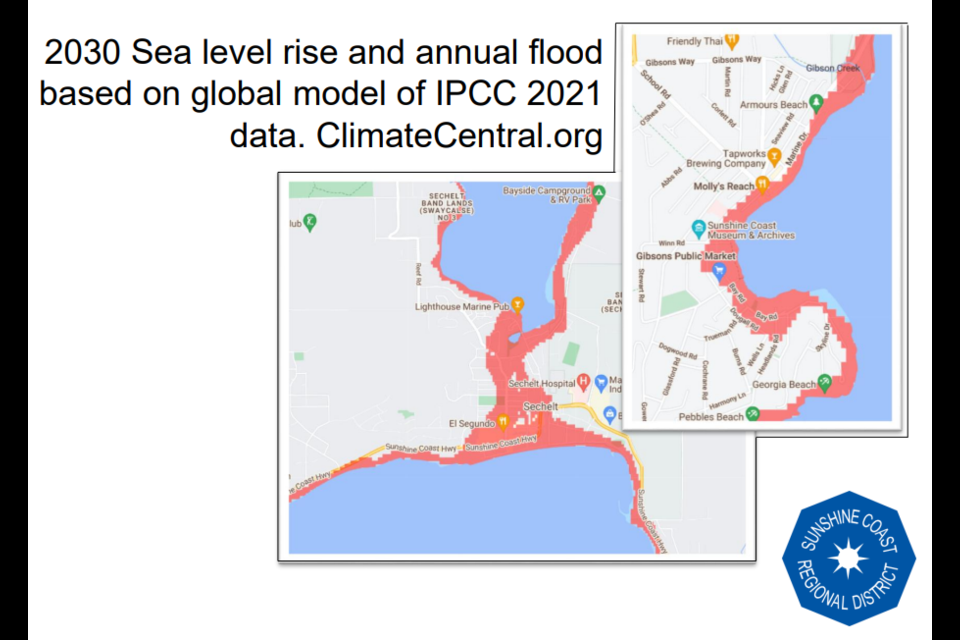In a committee of the whole meeting on June 8 — World Oceans Day — Sechelt council heard a presentation from the Sunshine Coast Regional District (SCRD) with some alarming predictions about climate change risks facing the region.
Raphael Shay of the SCRD presented highlights of the Sunshine Coast Community Climate Action Plan development and three recently completed reports: the climate science report, the greenhouse gas emissions inventory and the climate risk assessment report. During his report, Shay apologized for “being pretty depressing,” before turning to the action planning.
Responding to the climate emergency, Shay said, will include mitigation measures (including reducing greenhouse gas emissions) and adapting to inevitable changes “to foster a low carbon resilient community.”
For now, Shay said they’ll be educating the community about the results of the reports. As he presented, Shay said, “There's nothing that I'm sure you haven't heard before here.” The climate science report found that the Sunshine Coast can expect weeks of above 30-degree weather to become normal over the next few decades. A massive drop in the freeze-thaw cycle will increase the growing season for the agricultural sector. “We're expecting wetter winters and drier summers,” he said.
But it’s not just the averages staff are concerned about — it’s the increasing frequency and severity of extremes, Shay said. Nine of the last 13 summers have seen less precipitation than climate models are predicting for 2050, which is beyond the standard deviations presented. Last November’s atmospheric river on the Sunshine Coast was a one-in-25 year event, but could become a one-in-10 year event.
Most of the emissions come from transportation, including road and off-road transportation, such as BC Ferries’s use of diesel. The next major contributor is industry and construction, followed by residential use of gas heating. A 45 per cent reduction — in line with federal objectives — is possible for the Sunshine Coast by 2030, but it's very challenging, Shay said. The rate is currently predicted to flatline.
“Emissions have increased by more than seven per cent between 2007 and 2019,” Shay presented. “So we're on a slow increase trajectory, but our population has increased more so we are reducing our per capita emissions.”
The risk assessment report focused on nine risk priorities: Drought, wildfire, sea level rise, ocean acidification and warming, extreme weather, an increase in vector-borne diseases and pests such as Lyme disease, and the effects of rising temperatures on wildlife species, ecosystems and people. Monitoring temperatures of Chapman Creek show it’s often beyond the threshold for salmon, a keystone species. “Impacting salmon's ability to reproduce will have cascading effects,” Shay said.
When Shay showed a mapped prediction of how downtown Sechelt and the wastewater treatment plant would be underwater in the event of a surge event by 2030, Sechelt mayor Darnelda Siegers asked to confirm if the prediction was for eight years’ time. Noting that the global model may not be 100 per cent accurate, Say said, “It does raise some concerns around sea level rise combined with the king tide and storm surges events.” Later in the meeting, Siegers suggested sending a letter to the people who would be affected. Coun. Matt McLean raised a concern about how the active transportation plan could be impacted.
Another impact to residents of the Sunshine Coast flagged by Shay was the potential for increased violence exacerbated by climate emergencies, and especially after the social isolation caused by the pandemic.
Siegers asked how the SCRD’s Sustainable Development Division will work with the municipalities on the Coast, to which Shay said they are collaborating on a number of projects, and the final report will include recommendations the District of Sechelt can consider to act on.
Starting this month, the SCRD plans to engage with the community, set visions, goals and focus areas and brainstorm actions. Shay said something will hopefully be adopted by next year. In the first quarter of 2023, the action planning will be finalized. Then, implementation. “There is no time to wait,” he said.
More details from the reports can be found at letstalk.scrd.ca/climate.



